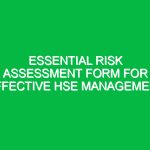Introduction
In today’s dynamic workplace Environment, ensuring health, safety, and environmental (HSE) success is paramount. A robust risk assessment plan serves as a cornerstone for achieving this goal. This document systematically identifies potential Hazards, evaluates risks, and outlines measures to mitigate them. A well-structured risk assessment plan sample is not just a formality; it’s a strategic tool that can save lives, reduce workplace accidents, and enhance compliance with Regulations. In this article, we will delve into what a risk assessment plan sample entails, its key components, and how it can be effectively utilized within the HSE framework.
Understanding Risk Assessment Plan Sample
A risk assessment plan sample is essentially a template that organizations can use to outline their approach to identifying and managing risks. This document includes various elements such as a description of the workplace, potential Hazards, risk evaluation methods, and Control Measures. The ultimate goal is to create a safer working environment by preemptively addressing potential issues.
When considering the HSE context, a risk assessment plan sample becomes even more critical. It integrates health and Safety practices with environmental considerations, aiming for a holistic approach to Workplace Safety. By analyzing potential risks not only to employees but also to the environment, organizations can develop comprehensive strategies that promote overall well-being.
Key Components of a Risk Assessment Plan Sample
To create an effective risk assessment plan sample, several key components must be included. Each plays a vital role in ensuring a thorough assessment of risks associated with workplace activities.
1. Workplace Description
This section provides an overview of the workplace, including its nature, operations, and workforce. A clear understanding of the work environment helps identify specific hazards. For instance, a construction site will have different risks compared to an office setting.
2. Hazard Identification
This component is focused on pinpointing potential hazards present in the workplace. Hazards can be physical, chemical, biological, ergonomic, or psychosocial. For example, in a manufacturing facility, machinery may pose mechanical hazards, while exposure to chemicals can introduce toxic hazards.
3. Risk Evaluation
After identifying hazards, the next step is to evaluate the associated risks. This involves determining the likelihood of the hazard causing harm and the severity of the potential consequences. A common approach is to use a risk matrix, which categorizes risks into levels such as low, medium, and high. This evaluation helps prioritize which risks need immediate attention.
4. Control Measures
Once risks have been evaluated, organizations must outline Control Measures to mitigate them. This could involve implementing engineering controls, administrative Procedures, or Personal Protective Equipment (PPE). For instance, if a construction site has identified a risk of falls, control measures might include installing guardrails or ensuring workers wear harnesses.
5. Monitoring and Review
A risk assessment is not a one-time exercise. It requires regular monitoring and review to ensure its effectiveness. This section should detail how often assessments will be reviewed and updated, especially when there are changes in the workplace or operations. Continuous improvement is key to maintaining a safe work environment.
6. Employee Involvement
Engaging employees in the risk assessment process is crucial. They can provide valuable insights into hazards they encounter daily. This collaborative approach not only enhances the assessment quality but also fosters a culture of Safety within the organization.
Benefits of a Risk Assessment Plan
Implementing a risk assessment plan sample has multiple Benefits for organizations operating in the HSE sector. Here are some key advantages:
- Improved Safety: A comprehensive risk assessment reduces the likelihood of accidents and injuries, ensuring a safer workplace for employees.
- Regulatory Compliance: Many industries are subject to regulations that require risk assessments. A well-documented plan helps organizations comply with these legal obligations.
- Enhanced Reputation: Organizations that prioritize safety and environmental concerns often enjoy a better reputation among customers, employees, and stakeholders.
- Cost Reduction: By preventing accidents and incidents, companies can save on potential costs related to medical treatment, legal fees, and lost productivity.
- Employee Engagement: Involving employees in the risk assessment process encourages a proactive approach to safety and can lead to increased morale and productivity.
Best Practices for Developing a Risk Assessment Plan Sample
Creating an effective risk assessment plan sample requires adherence to certain Best Practices. Here are some strategies to consider:
1. Use Clear Language
Avoid jargon and technical terms that may confuse employees. A risk assessment plan should be easily understood by all stakeholders, including those without a background in health and safety.
2. Tailor to Your Organization
Each workplace is unique, so it’s essential to customize the risk assessment plan to fit the specific operations and hazards of your organization. Generic templates may not adequately address unique risks.
3. Engage Stakeholders
Involve various stakeholders in the development of the risk assessment plan. This includes management, employees, safety officers, and environmental experts. Their collective insights can lead to a more comprehensive assessment.
4. Document Everything
Thorough documentation is critical in the risk assessment process. Ensure that all identified hazards, evaluations, and control measures are recorded. This documentation not only serves as a reference but is also essential for compliance audits.
5. Provide Training
Once the risk assessment plan is developed, conduct training sessions for employees to ensure they understand the risks and the necessary control measures. Continuous training fosters a culture of safety and awareness.
Regulations and Standards Governing Risk Assessment
Understanding the regulations and standards that govern risk assessment plans is vital for compliance and effective implementation. Various organizations and governmental entities have established guidelines to ensure Workplace Safety.
1. OSHA Standards
In the United States, the Occupational Safety and Health Administration (osha) sets forth regulations that require employers to conduct risk assessments and implement Safety Measures. These standards are crucial for protecting workers from hazards.
2. ISO 45001
The International Organization for Standardization (ISO) has established ISO 45001, which outlines requirements for an Occupational Health and safety management system. This standard encourages organizations to proactively manage risks and improve safety performance.
3. Environmental Regulations
In addition to health and safety regulations, organizations must also comply with environmental regulations. The Environmental Protection Agency (EPA) in the U.S. mandates risk assessments for activities that may impact the environment.
Real-Life Examples and Hypothetical Scenarios
To further illustrate the importance of a risk assessment plan sample, consider the following real-life example:
A manufacturing company experienced several accidents due to machine-related injuries. Upon conducting a risk assessment, they identified the machinery as a significant hazard. They implemented a series of control measures, including regular Maintenance checks, installation of safety guards, and employee training. Over time, the number of accidents decreased significantly, demonstrating the effectiveness of a well-structured risk assessment plan.
Now, let’s consider a hypothetical scenario:
Imagine a construction site where a new project is about to begin. The project manager conducts a risk assessment and identifies potential hazards such as falls, equipment accidents, and exposure to hazardous materials. By preparing a risk assessment plan sample that includes control measures—like safety harnesses, regular tool inspections, and proper material handling procedures—they can prevent accidents before they occur. This proactive approach not only protects workers but also enhances the project’s overall success.
Conclusion
In summary, a well-crafted risk assessment plan sample is essential for ensuring health, safety, and environmental success in any organization. By systematically identifying hazards, evaluating risks, and implementing control measures, organizations can create a safer working environment for employees while complying with legal standards. The benefits of a risk assessment plan extend beyond mere compliance; they foster a culture of safety, reduce costs, and enhance organizational reputation.
As we move forward in an ever-evolving work environment, it’s crucial for organizations to prioritize the development and implementation of effective risk assessment plans. By doing so, they not only protect their workforce but also contribute to a sustainable future for the environment. Adopting Best Practices, staying informed about regulations, and engaging employees are vital steps towards achieving HSE success.


